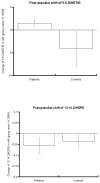Integrating multi-omics biomarkers and postprandial metabolism to develop personalized treatment for anorexia nervosa
- PMID: 28232135
- PMCID: PMC5565718
- DOI: 10.1016/j.prostaglandins.2017.02.002
Integrating multi-omics biomarkers and postprandial metabolism to develop personalized treatment for anorexia nervosa
Abstract
Background: Anorexia Nervosa (AN) is a serious mental illness characterized by emaciation, an intense fear of gaining weight despite being underweight, and distorted body image. Few treatments reverse the core symptoms in AN such as profound aversion to food and food avoidance. Consequently, AN has a chronic and relapsing course and the highest mortality rate of any psychiatric illness. A more complete understanding of the disease pathogenesis is needed in order to develop better treatments and improve AN outcome. The pathogenesis and psychopathophysiology of AN can be better elucidated by combining longitudinal phenotyping with multiple "omics" techniques, including genomics, proteomics, lipidomics, and metabolomics.
Design: This paper summarizes the key findings of a series of interrelated studies including new experimental data and previously published data, and describes our current initiatives and future directions.
Results: Exon sequencing data was analyzed in 1205 AN and 1948 controls. Targeted metabolomics, lipidomics, and proteomics data were collected in two independent convenience samples consisting of 75 subjects with eating disorders and 61 sex- and age-matched healthy controls. Study participants were female and the mean age was 22.9 (4.9 [SD]) years. Epoxide hydrolase 2 (EPHX2) genetic variations were significantly associated with AN risk, and epoxide hydrolase (sEH) activity was elevated in AN compared to controls. The polyunsaturated fatty acids (PUFAs) and eicosanoids data revealed that cytochrome P450 pathway was implicated in AN, and AN displayed a dysregulated postprandial metabolism of PUFAs and sEH-dependent eicosanoids.
Implication and current initiatives: Collectively, our data suggest that dietary factors may contribute to the burden of EPHX2-associated AN susceptibility and affect disease outcome. We are implementing new investigations using a longitudinal study design in order to validate and develop an EPHX2 multi-omics biomarker system. We will test whether sEH-associated postprandial metabolism increases AN risk and affects treatment outcome through an ω-6 rich breakfast challenge. Participants will include 100 ill AN patients, 100 recovered AN patients, and 100 age- and race-matched healthy women. These data will allow us to investigate 1) how genetic and dietary factors independently and synergistically contribute to AN risk and progression, and 2) if clinical severity and treatment response in AN are affected by sEH activity and eicosanoid dysregulation. Results of our study will 1) identify clinically relevant biomarkers, 2) unravel mechanistic functions of sEH, and 3) delineate contributory roles of dietary PUFAs and cytochrome P450 pathway eicosanoids for the purpose of developing novel AN treatments and improving disease prognosis.
Keywords: Anorexia nervosa; Bioactive lipid mediators; Cytochrome P450 pathway; EPHX2; Eating disorder; Epoxides and diols; Genetic polymorphism; Inflammation; Inflammatory biomarkers; Lipidomics; Metabolomics; Nutritional intervention; Personalized treatment development; Polyunsaturated fatty acids; Psychiatric metabolomics; Soluble epoxide hydrolase.
Copyright © 2017 Elsevier Inc. All rights reserved.
Figures




Similar articles
-
Personalized polyunsaturated fatty acids as a potential adjunctive treatment for anorexia nervosa.Prostaglandins Other Lipid Mediat. 2017 Nov;133:11-19. doi: 10.1016/j.prostaglandins.2017.08.010. Epub 2017 Sep 2. Prostaglandins Other Lipid Mediat. 2017. PMID: 28873340 Free PMC article. Review.
-
Dysregulation of soluble epoxide hydrolase and lipidomic profiles in anorexia nervosa.Mol Psychiatry. 2016 Apr;21(4):537-46. doi: 10.1038/mp.2015.26. Epub 2015 Mar 31. Mol Psychiatry. 2016. PMID: 25824304 Free PMC article.
-
Fasting and postprandial soluble epoxide hydrolase-associated eicosanoids of remitted patients with eating disorder.Data Brief. 2018 Jan 31;17:334-338. doi: 10.1016/j.dib.2018.01.028. eCollection 2018 Apr. Data Brief. 2018. PMID: 29876402 Free PMC article.
-
Postprandial effect to decrease soluble epoxide hydrolase activity: roles of insulin and gut microbiota.J Nutr Biochem. 2017 Nov;49:8-14. doi: 10.1016/j.jnutbio.2017.07.006. Epub 2017 Jul 21. J Nutr Biochem. 2017. PMID: 28863368 Free PMC article.
-
Metabolic/inflammatory/vascular comorbidity in psychiatric disorders; soluble epoxide hydrolase (sEH) as a possible new target.Neurosci Biobehav Rev. 2018 Apr;87:56-66. doi: 10.1016/j.neubiorev.2018.01.010. Epub 2018 Feb 2. Neurosci Biobehav Rev. 2018. PMID: 29407524 Free PMC article. Review.
Cited by
-
The Discovery of Clinically Applicable Biomarkers for Bipolar Disorder: A Review of Candidate and Proteomic Approaches.Chonnam Med J. 2020 Sep;56(3):166-179. doi: 10.4068/cmj.2020.56.3.166. Epub 2020 Sep 24. Chonnam Med J. 2020. PMID: 33014755 Free PMC article. Review.
-
Unveiling Metabolic Phenotype Alterations in Anorexia Nervosa through Metabolomics.Nutrients. 2021 Nov 26;13(12):4249. doi: 10.3390/nu13124249. Nutrients. 2021. PMID: 34959800 Free PMC article. Review.
-
Personalized polyunsaturated fatty acids as a potential adjunctive treatment for anorexia nervosa.Prostaglandins Other Lipid Mediat. 2017 Nov;133:11-19. doi: 10.1016/j.prostaglandins.2017.08.010. Epub 2017 Sep 2. Prostaglandins Other Lipid Mediat. 2017. PMID: 28873340 Free PMC article. Review.
-
Structural Neuroimaging of Anorexia Nervosa: Future Directions in the Quest for Mechanisms Underlying Dynamic Alterations.Biol Psychiatry. 2018 Feb 1;83(3):224-234. doi: 10.1016/j.biopsych.2017.08.011. Epub 2017 Aug 24. Biol Psychiatry. 2018. PMID: 28967386 Free PMC article. Review.
-
Evaluation of Metabolic Profiles of Patients with Anorexia Nervosa at Inpatient Admission, Short- and Long-Term Weight Regain-Descriptive and Pattern Analysis.Metabolites. 2020 Dec 24;11(1):7. doi: 10.3390/metabo11010007. Metabolites. 2020. PMID: 33374417 Free PMC article.
References
-
- American Psychiatric Association. American Psychiatric Association, Diagnostic and Statistical Manual of Mental Disorders. 5. Washington, DC: 2013.
-
- Arcelus J, Mitchell AJ, Wales J, Nielsen S. Mortality rates in patients with anorexia nervosa and other eating disorders. A meta-analysis of 36 studies Archives of general psychiatry. 2011;68(7):724–731. - PubMed
-
- Steinhausen HC. The outcome of anorexia nervosa in the 20th century. The American journal of psychiatry. 2002;159(8):1284–1293. - PubMed
-
- Strober M, Freeman R, Lampert C, Diamond J, Kaye W. Controlled family study of anorexia nervosa and bulimia nervosa: evidence of shared liability and transmission of partial syndromes. The American journal of psychiatry. 2000;157(3):393–401. - PubMed
Publication types
MeSH terms
Substances
Grants and funding
LinkOut - more resources
Full Text Sources
Other Literature Sources
Medical

